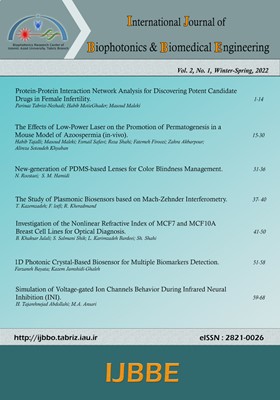-
-
List of Articles
-
Open Access Article
1 - Protein- Protein Interaction network analysis for Discovering Potent Candidate Drugs in Female Infertility
Parinaz Tabrizi-Nejhadi Habib MotieGhader Masoud Maleki -
Open Access Article
2 - The effects of low-power laser on the promotion of spermatogenesis in a mouse model of azoospermia (in-vivo)
Habib Tajalli Masoud Maleki Esmail Safavi Reza Shahi Fatemeh Firoozi Zahra Akbarpour Alireza Sotoudeh Khyaban -
Open Access Article
3 - The Study of Plasmonic Biosensors based on Mach-Zehnder Interferometry
Reza Kheradmand Tanin Kazemzadeh Fariba Lotfi -
Open Access Article
4 - Investigation of the Nonlinear Refractive Index of MCF7 and MCF10A Breast Cell Lines for Optical Diagnosis
Bahareh Khaksar Jalali Somayeh Salmani Shik Latifeh Karimzadeh Bardee sharifeh shahi -
Open Access Article
5 - 1D Photonic Crystal-Based Biosensor for Multiple Biomarkers Detection
Farzaneh Bayat Kazem Jamshidi-Ghaleh -
Open Access Article
6 - Simulation of voltage-gated ion channels behavior during infrared neural inhibition (INI)
Mohamamd Ali Ansari Hassan Tajarehnejad Abdollahi -
Open Access Article
7 - New-generation of PDMS-based Lenses for Color Blindness management
Seyedeh Mehri Hamidi neda Roostaei
-
The rights to this website are owned by the Raimag Press Management System.
Copyright © 2021-2025







